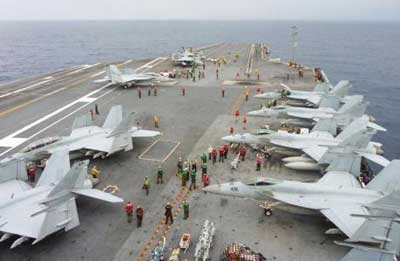
With new air zone, China tests US
Beijing, November 30, 2013
China's new air defence zone, stretching far into East Asia's international skies, is an historic challenge to the United States, which has dominated the region for decades, say experts.
For years, Chinese naval officers have told their US counterparts they are uncomfortable with America's presence in the western Pacific - and Beijing is now confronting strategic assumptions that have governed the region since World War Two.
China's recent maritime muscle-flexing in disputes over the Paracel islands and Scarborough Shoal in the South China Sea and over Japanese-administered islands in the East China Sea has stirred concern and extensive backroom diplomacy in Washington.
But it took the events of the last week to spark an immediate and symbolic response from the United States - the unannounced appearance in the zone of two unarmed B-52 bombers from the fortified island of Guam, the closest US territory to the Chinese coast.
China's unilateral creation of the zone - accompanied by warnings that it would take "defensive emergency measures" against aircraft that didn't identify themselves - has raised the stakes in a territorial dispute with Japan over tiny, uninhabited islands in the area.
Even as some suggest Beijing's move is already backfiring, experts in China say it is a part of a long-term effort, carrying broader historic significance for the United States as the traditional provider of Japanese security.
The regional tensions will loom large when US Vice President Joe Biden travels to Japan, China and South Korea early next week.
Shi Yinhong, a professor of international relations at Renmin University who advises Beijing's State Council, said Washington had recognized China as a great trade and diplomatic power, and should now acknowledge China needs its own "strategic space".
"How the US and its allies recognize that will be vital to the future of the region," he said. "This (zone) could cause the US to have more profound strategic thinking about China's rise."
A Chinese analyst with ties to the military warned Tokyo and Washington against mistaking Beijing as a "paper tiger", adding that US surveillance flights near China's coast - such as one that sparked a fatal collision over Hainan Island in 2001 - "will never be allowed to happen again."
Japan and South Korea, another treaty ally of the US, also sent military aircraft through the zone this week without informing China, lending muscle to earlier diplomatic protests.
For all the apparent boldness of China's move, some regional analysts believe Beijing has over-reached, in comparison to earlier campaigns of assertion. For example, China's rotating presence of ships in seas around Japan's Senkaku islands, which China claims and calls the Diaoyu, have continued without sparking a direct military response from Washington.
Some suggest the fact that Chinese planes have yet to attempt an interception in the air this week, despite the swift flouting of its demands, shows that Beijing's bluff has been called. They are also puzzled how the move fits with Beijing's vaunted "soft power" diplomacy - on display recently as China's leaders toured South East Asia after US President Barack Obama pulled out of a long-planned trip.
"What (President) Xi Jinping is trying to do is create a balance between soft and hard, conservatives and liberals. This is part of their trial and error process to get the right balance," said former senior Japanese diplomat Hitoshi Tanaka.
The fact China's zone overlaps Japan's - including contested islands that the US is obliged to defend under its treaty with Japan - represents a dangerous strategic shift, US officials say. And China's declaration it could take action against unidentified aircraft that ignored its warnings has sparked fears of an increased risk of accidents and miscalculations.
"It causes friction and uncertainty, it constitutes a unilateral challenge to the status quo in ... a region that is already fraught," one US administration official said.
A Long Game?
In Tokyo, too, there is a sense that China is playing a long-term game - even if Beijing struggles to enforce a move some analysts described as poorly thought out.
Speaking privately, one government source said that while it could damage Japan's "effective control" of disputed islands in the short-term, in the longer term it represented a push by Beijing to create a broad defensive zone across the East and South China Seas.
"They don't feel safe without vast space between themselves and their enemies," the person said.
Narushige Michishita, a security expert at Tokyo's National Graduate Institute for Policy Studies, described the zone as a "bad step" for both Japan and China. "So far, China's move has backfired on it, but it might have longer term ... or internal political objectives," he said. "We should be cautious."
In China, there is a palpable sense of historic mission.
"China's actions are a way of facing up to the US escalation of military power in the region," said Ni Lexiong, a defense analyst at the Shanghai University of Political Science and Law. "This is an issue of face and respect."
"It's also about national interests. You have to look in the context of history - there have been many agrarian countries that have developed their economies and then transformed into naval powers. It's a consequence of a country doing business globally. It's normal," he noted.-Reuters







